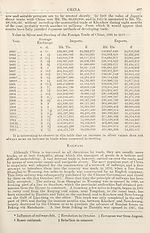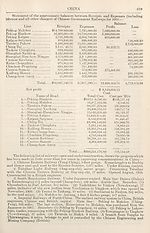1917
(772) Page 678
Download files
Complete book:
Individual page:
Thumbnail gallery: Grid view | List view

CHINA
Peking terminus being at Machiapu, a point two miles from the Tartar city, whence a
short electric line connected it with one of the principal gates ; the traffic developed so
rapidly that in 1898-9 the line had to be doubled. .From Lukouchiao (or Marco Polo’s
Bridge) a line of about eighty miles in length was constructed southward to Paoting-
:fu, the capital of the province of Chihli; this line, in October, 1899, was handed over
by the British constructors to the Belgian Syndicate as an integral factor in the great
trans-continental line from Peking to Hankow. These lines were all more or less
•deliberately and in some parts completely destroyed by the Chinese during 1900. The
Railways, as foreign innovations, were particularly hateful to the Boxers, who in many
•cases attacked the lines with a fury as intense as it was insensate : burning the stations,
•destroying bridges, tiring the sleepers and carrying olf the metals. Later on, track
destruction was a strong feature of the strategy of the Imperial troops, and from their
point of view, wisely so. It was the cutting of the Railway that was the sole cause of
Admiral Seymour’s failure in his gallant attempt to rescue the Legations. All the
lines in North China were attacked and badly cut. Some then the terminus at Peking
has been brought inside the Chinese City at the Chien Men or Southern Gate of the
Manchu City, and the construction of a circular railway to link up the various grand
trunk termini in Peking has made progress, the railway running round three parts of
the city. Later, it is prohosed to erect a grand central station. A branch line has
been made from the Chien Men terminus to Tung Chow, the head of the water-ways;
and both the French and Germans pushed on the trunk lines being built under their
-exclusive auspices in Chihli, Honan, and in Shantung, respectively but this work has
been suspender since outbreak of the Europeon war. Railway vandalism was the first
•evidence of the savagery and magnitude of the Boxer sedition. It is significant that
the Imperial Government was so inert in protecting its own property. Now, however,
there is no need to preach the gospel of railway construction, and only lack of funds
•retards the completion of many new lines.
An official report issued in 1916 showed that the operated mileage of Government
Railways was 3,543 miles, t<> which have to be added 150 miles of private lines and 1,500
-of “concessioned lines”; in all, 5,193 miles. It is interesting to note that the greater
part of railway construction has taken place north of the Yangtsze River, if the
Shanghai Nanking Railway be included—and from the commercial point of view it
-should be grouped with the Northern interests-only 10.372 per cent, of the total
operating mileage in China des south of the Yangtsze waterway. In plans for future
constructions, however, Southern China is well provided with prospective lines. An
important development took place in 1916 when the American firm of Siems & Carey
signed, on May 17th, a contract with the Chinese Government for the. building of
railways in China. On September 29th the detailed plan for the working out of the
original agreement was decided upon. Under these agreements Siems & Carey are
to have entire charge of the construction of the railways to be built under the contract,
and the American International Corporation (with which Siems <fc Carey is affiliated)
has undertaken the flotation of the bonds for the Chinese Government in this work.
The railways contemplated are as follows, though it is provided that if they are nof>
feasible equal mileage shall be allotted elsewhere in China :
1. —From Fengcheng in Shansi Province to Ningsia in Kansu Province.
2. —From Ningsia in Kansu Province to Lanchowfu in Kansu Province.
3. —From Hangchow in Chekiang Province to Wenchow in Chekiang Province.
4. —From Hengchowfu in Hunan Province to Nanning in Kwangsi Province.
5. —From Lu Hwei in Kwangtung Province to Chungchow in Kwangtung Province^
These lines are to be built upon a percentage basis as initiated by Pauling &
■Company in their'Shasi-Shingyifu railway agreement
Great diversity exists on Chinese Railways in the type of locomotives used, due to the
fact that the funds for constructing the various railways were furnished by different
foreign markets, and in many of the loan agreements it is stated by implication,_ at
least, that other things being equal the country that makes the loan should enjoy
preference in furnishing the material for construction.
Before studying the appended tables it should be borne in mind that the com¬
paratively high percentage of general expenses in China is to some extent due to the fact
that considerable forces of police have to be maintained by the railways and that the
use of foreign languages always necessitates the duplication of correspondence, and
extra work of translation. Another canse is that the mileage operated by each Ad¬
ministration is comparatively small, averaging le.=s than 230 miles.
Peking terminus being at Machiapu, a point two miles from the Tartar city, whence a
short electric line connected it with one of the principal gates ; the traffic developed so
rapidly that in 1898-9 the line had to be doubled. .From Lukouchiao (or Marco Polo’s
Bridge) a line of about eighty miles in length was constructed southward to Paoting-
:fu, the capital of the province of Chihli; this line, in October, 1899, was handed over
by the British constructors to the Belgian Syndicate as an integral factor in the great
trans-continental line from Peking to Hankow. These lines were all more or less
•deliberately and in some parts completely destroyed by the Chinese during 1900. The
Railways, as foreign innovations, were particularly hateful to the Boxers, who in many
•cases attacked the lines with a fury as intense as it was insensate : burning the stations,
•destroying bridges, tiring the sleepers and carrying olf the metals. Later on, track
destruction was a strong feature of the strategy of the Imperial troops, and from their
point of view, wisely so. It was the cutting of the Railway that was the sole cause of
Admiral Seymour’s failure in his gallant attempt to rescue the Legations. All the
lines in North China were attacked and badly cut. Some then the terminus at Peking
has been brought inside the Chinese City at the Chien Men or Southern Gate of the
Manchu City, and the construction of a circular railway to link up the various grand
trunk termini in Peking has made progress, the railway running round three parts of
the city. Later, it is prohosed to erect a grand central station. A branch line has
been made from the Chien Men terminus to Tung Chow, the head of the water-ways;
and both the French and Germans pushed on the trunk lines being built under their
-exclusive auspices in Chihli, Honan, and in Shantung, respectively but this work has
been suspender since outbreak of the Europeon war. Railway vandalism was the first
•evidence of the savagery and magnitude of the Boxer sedition. It is significant that
the Imperial Government was so inert in protecting its own property. Now, however,
there is no need to preach the gospel of railway construction, and only lack of funds
•retards the completion of many new lines.
An official report issued in 1916 showed that the operated mileage of Government
Railways was 3,543 miles, t<> which have to be added 150 miles of private lines and 1,500
-of “concessioned lines”; in all, 5,193 miles. It is interesting to note that the greater
part of railway construction has taken place north of the Yangtsze River, if the
Shanghai Nanking Railway be included—and from the commercial point of view it
-should be grouped with the Northern interests-only 10.372 per cent, of the total
operating mileage in China des south of the Yangtsze waterway. In plans for future
constructions, however, Southern China is well provided with prospective lines. An
important development took place in 1916 when the American firm of Siems & Carey
signed, on May 17th, a contract with the Chinese Government for the. building of
railways in China. On September 29th the detailed plan for the working out of the
original agreement was decided upon. Under these agreements Siems & Carey are
to have entire charge of the construction of the railways to be built under the contract,
and the American International Corporation (with which Siems <fc Carey is affiliated)
has undertaken the flotation of the bonds for the Chinese Government in this work.
The railways contemplated are as follows, though it is provided that if they are nof>
feasible equal mileage shall be allotted elsewhere in China :
1. —From Fengcheng in Shansi Province to Ningsia in Kansu Province.
2. —From Ningsia in Kansu Province to Lanchowfu in Kansu Province.
3. —From Hangchow in Chekiang Province to Wenchow in Chekiang Province.
4. —From Hengchowfu in Hunan Province to Nanning in Kwangsi Province.
5. —From Lu Hwei in Kwangtung Province to Chungchow in Kwangtung Province^
These lines are to be built upon a percentage basis as initiated by Pauling &
■Company in their'Shasi-Shingyifu railway agreement
Great diversity exists on Chinese Railways in the type of locomotives used, due to the
fact that the funds for constructing the various railways were furnished by different
foreign markets, and in many of the loan agreements it is stated by implication,_ at
least, that other things being equal the country that makes the loan should enjoy
preference in furnishing the material for construction.
Before studying the appended tables it should be borne in mind that the com¬
paratively high percentage of general expenses in China is to some extent due to the fact
that considerable forces of police have to be maintained by the railways and that the
use of foreign languages always necessitates the duplication of correspondence, and
extra work of translation. Another canse is that the mileage operated by each Ad¬
ministration is comparatively small, averaging le.=s than 230 miles.
Set display mode to:
![]() Universal Viewer |
Universal Viewer | ![]() Mirador |
Large image | Transcription
Mirador |
Large image | Transcription
Images and transcriptions on this page, including medium image downloads, may be used under the Creative Commons Attribution 4.0 International Licence unless otherwise stated. ![]()
| Asian directories and chronicles > 1917 > (772) Page 678 |
|---|
| Permanent URL | https://digital.nls.uk/194542344 |
|---|
| Attribution and copyright: |
|
|---|---|
| Description | Volumes from the Asian 'Directory and Chronicle' series covering 1917-1941, but missing 1919 and 1923. Compiled annually from a multiplicity of local sources and research. They provide listings of each country's active corporations, foreign residents and government agencies of all nationalities for that year, together with their addresses. Content includes: various treaties; coverage of conflicts; currencies and taxes; consular fees; weights and measures; public holidays; festivals and traditions. A source of information for both Western states and communities of foreigners living in Asia. Published by Hongkong Daily Press. |
|---|---|
| Shelfmark | H3.86.1303 |
| Additional NLS resources: |

